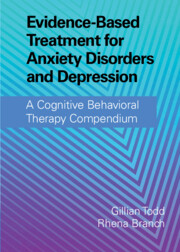 Evidence-Based Treatment for Anxiety Disorders and Depression
Evidence-Based Treatment for Anxiety Disorders and Depression Book contents
- Evidence-Based Treatment for Anxiety Disorders and Depression
- Evidence-Based Treatment for Anxiety Disorders and Depression
- Copyright page
- Contents
- Figures
- Tables
- Contributors
- 1 Introduction
- 2 The History and Philosophical Underpinnings of CBT:
- Part One Cognitive Behavioral Therapy for Anxiety Disorders
- Part Two Cognitive Behavioral Therapy for Posttraumatic Stress Disorder
- Part Three Cognitive Behavioral Therapy for Obsessive-Compulsive Disorder and Associated Disorders
- Part Four Cognitive Behavioral Therapy for Depression
- Part Five Complexity and Comorbidity in Anxiety Disorders and Depression:
- Part Six Specialist Applications of Cognitive Behavioral Therapy for Anxiety Disorders and Depression
- 24 The Application of CBT for Adults with Learning Disabilities
- 25 Cognitive Behavioral Therapy for Children and Adults with Autism
- 26 Adapting CBT for Treating Anxiety Disorders and Depression in Adults with ADHD
- 27 Adapting CBT for Children and Adolescents with Anxiety Disorders and Depression
- 28 Adapting Cognitive Behavioral Therapy for Older Adults with Anxiety Disorders and Depression
- 29 Cross-Cultural CBT
- Part Seven Future Developments
- Appendices
- Index
- References
24 - The Application of CBT for Adults with Learning Disabilities
from Part Six - Specialist Applications of Cognitive Behavioral Therapy for Anxiety Disorders and Depression
Published online by Cambridge University Press: 06 January 2022
- Evidence-Based Treatment for Anxiety Disorders and Depression
- Evidence-Based Treatment for Anxiety Disorders and Depression
- Copyright page
- Contents
- Figures
- Tables
- Contributors
- 1 Introduction
- 2 The History and Philosophical Underpinnings of CBT:
- Part One Cognitive Behavioral Therapy for Anxiety Disorders
- Part Two Cognitive Behavioral Therapy for Posttraumatic Stress Disorder
- Part Three Cognitive Behavioral Therapy for Obsessive-Compulsive Disorder and Associated Disorders
- Part Four Cognitive Behavioral Therapy for Depression
- Part Five Complexity and Comorbidity in Anxiety Disorders and Depression:
- Part Six Specialist Applications of Cognitive Behavioral Therapy for Anxiety Disorders and Depression
- 24 The Application of CBT for Adults with Learning Disabilities
- 25 Cognitive Behavioral Therapy for Children and Adults with Autism
- 26 Adapting CBT for Treating Anxiety Disorders and Depression in Adults with ADHD
- 27 Adapting CBT for Children and Adolescents with Anxiety Disorders and Depression
- 28 Adapting Cognitive Behavioral Therapy for Older Adults with Anxiety Disorders and Depression
- 29 Cross-Cultural CBT
- Part Seven Future Developments
- Appendices
- Index
- References
Summary
This chapter provides an evidence-based overview of predominantly cognitive behavioral interventions for common mental disorders, that is, anxiety and depression, undertaken in the field of intellectual disabilities (ID). The evidence was generated by reviewing international publications between 1980 and 2020 which identified the use of cognitive behavioral therapy (CBT), including third wave CBT therapies, and was also informed by our extensive clinical practice in the field of ID. The first section provides an outline of the historical and sociological context of psychological therapies and the possible barriers to CBT in an ID population. The chapter includes a summary of how intellectual disabilities, depression, and anxiety disorders are defined. It considers key issues, problems and solutions associated with applying CBT and its associated approaches in an ID population. Finally, two case vignettes introduce the reader to CBT techniques to illustrate ideas that will help clients using CBT to bring about a reduction in self-defeating behaviors. With the aid of a support worker and electronic sources, there is a much broader range of resources to help client and therapist journey and support the therapeutic alliance.
- Type
- Chapter
- Information
- Evidence-Based Treatment for Anxiety Disorders and DepressionA Cognitive Behavioral Therapy Compendium, pp. 507 - 532Publisher: Cambridge University PressPrint publication year: 2022


